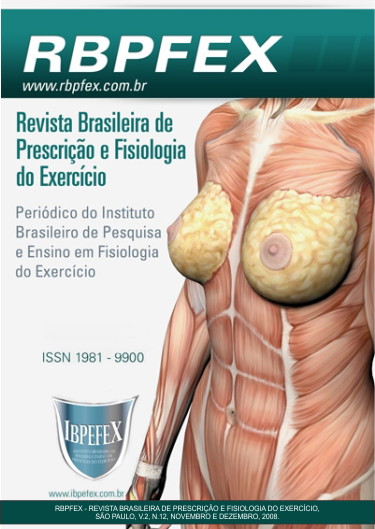Comparison of the corporal composition and level of physical activity between pertaining to school of the private unit and another public of Goiânia
Abstract
Introduction: Practical the regular one of physical activity brings considerable benefits to the health of the individual. Reduction of the cardiac frequency of rest, reduction of the risk of cardiovascular problems and relief of stress is only some of the gamma of benefits that the regular physical activity can provide. Objective: To compare the level of physical activity and the corporal composition in pupils of a municipal public school and another particular one of Goiânia-GO. Materials and methods: The experiment was carried through of transversal form. The sample was composed for 218 pertaining to school with age understood between 11 and 15 years, being that 50% studied in a particular school and the others in a State public school, both in the city of Goiânia. The pupils had answered questionnaire IPAQ in the complete one and had made an evaluation of corporal composition. Conclusion: One perceived that the pertaining to school of the public unit present one better level of physical activity in comparison with the pertaining to school of the evaluated particular unit. With regard to the percentage of corporal fat, the pertaining to school of the particular unit had presented a average of percentage above of the pertaining to school of thepublic net, as much for the masculine sort how much for the feminine one.
References
- Albuquerque, M.F.M; Monteiro, A.M. Ingestão de alimentos e adequação de nutrientes no final da infância. Revista de Nutrição. set-dez. 2002.
- Alves, A.K.L. Por que meu filho não quer comer?. Revista Nutriweb. v. 1, n. 2, nov-dez, 1999. Disponível em: <http://www.nutriweb.org.br/n0102/naoquer.htm.> acesso em 25/11/2206 17:04.
- Barros Neto, T.L.; e colaboradores. Respostas cardiorrespiratórias ao exercício em indivíduos portadores de hipotrofia por imobilização. Revista Brasileira de Ciência e Movimento, Brasília-DF. v. 8, n. 1, p. 35-42. jan 2000.
- Castro, A.S; Morgan, C.M. Obesidade infantil. In: SCHOR. N. Guia de transtornos alimentares e obesidade. Barueri, SP: Manole, 2005.
- Cole, T.J.; Belizzi, M.C.; Flegal, K.M.; Dietz, W.H. Establishing a standard definition for child overweight and obesity worldwide: international survey. B.M.J.. v. 320; 1240- 2000.
- Costa, R.F.; Cintra, I.P.; Fisberg, M. Prevalência de Sobrepeso e Obesidade em escolares da cidade de Santos, SP. Arquivo Brasileiro de Endocrinologia e Metabologia. São Paulo, v. 50: 60-67. n°1, fev. 2006.
- Domingues Filho, L.A. Obesidade & atividade física. Jundiaí: Fontoura Editora, 2000. 140 p.
- Ferreira, M.; e colaboradores. Efeitos de um programa de atividade física e nutricional sobre o nível de atividade física de mulheres ativas de 50 a 72 anos de idade. Revista Brasileira de Medicina do Esporte, Niterói-RJ. v. 11, n. 3, p. 173. maio/jun. 2005.
- Figueiredo, B.C.A. Perfil de Adiposidade e Composição Corporal dos iniciantes de Judô da UniEVANGÉLICA em 2007. Trabalho de conclusão de curso de Educação Física. UniEVANGLÉGICA, 2007.
- Glaner, M.F. Concordância de questionários de atividade física com a aptidão cardiorrespiratória. Revista Brasileira de Cineantropometria & Desempenho Humano. 2007;9(1):61-66. ISSN 1980-0037.
- Melo, G.F.; e colaboradores. Análise do nível de atividade física nas casas de repouso e instituições filantrópicas (asilos) do Distrito Federal. http://www.efdeportes.com/ Revista Digital - Buenos Aires - Ano 9 - N° 62 – jul. 2003.
- Organização Pan-Americana De Saúde/Organização Mundial De Saúde. Doenças crônico-degenerativas obesidade: Estratégia mundial sobre alimentação saudável, atividade física e saúde. Brasília; OMS, 2003. p. 1-34.
- Pardini, R.; e colaboradores. Validação do questionário internacional de atividade física (IPAQ- Versão 6): estudo piloto em adultos jovens brasileiros. Revista Brasileira de Ciência e Movimento. Brasília-DF. v. 9, n. 3, p. 45-51. jul. 2001.
- Philippi, S.T.; Cruz, A.T.R.; Colucci, A.C.A. Pirâmide alimentar para crianças de 2 a 3 anos. Revista de Nutrição. v. 16, n. 1, jan-mar, 2003, p. 5–13.
- Pitanga, F.J.G. Testes, Medidas e Avaliação em Educação Física e Esporte. 4ª edição. São Paulo: Phorte, 2005.
- Slaughter, M.H.; Lohman, T.G.; Boileau, R.A.; Horswill, C.A.; Stillman, R.J.; Van Loan, M.D. Bemben, D.A.; Skinfold equations for estimation of body fatness in children and youth. Hum Biol 60:709–723, 1988.
- Ukkola, O.; Bouchard, C. Fatores genéticos da obesidade infantil. Anais Nestlé, v. 62, p. 12-21. 2002.
Authors who publish in this journal agree to the following terms:
- Authors retain the copyright and grant the journal the right of first publication, with work simultaneously licensed under the Creative Commons Attribution License BY-NC which allows the sharing of the work with acknowledgment of the authorship of the work and initial publication in this journal.
- Authors are authorized to enter into additional contracts separately for non-exclusive distribution of the version of the work published in this journal (eg, publishing in institutional repository or book chapter), with acknowledgment of authorship and initial publication in this journal.
- Authors are allowed and encouraged to post and distribute their work online (eg, in institutional repositories or on their personal page) at any point before or during the editorial process, as this can bring about productive change as well as increase impact and impact. citation of published work (See The Effect of Free Access).






